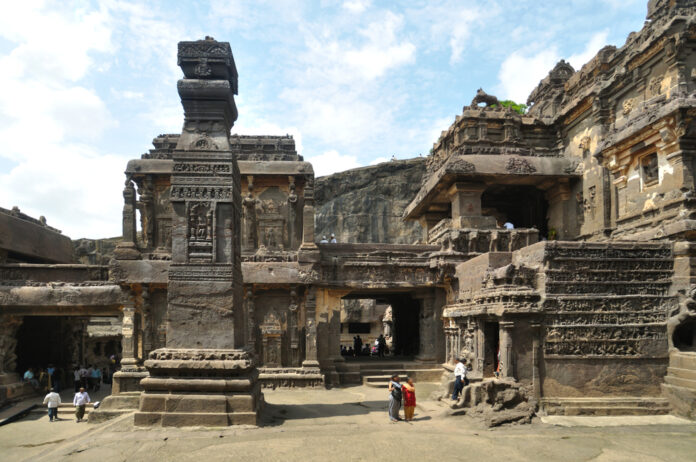Places to Visit in Aurangabad
Aurangabad, a historical city in Maharashtra, India, is renowned for its rich cultural heritage and historical significance. Named after the Mughal emperor Aurangzeb, this city boasts an array of architectural marvels, ancient monuments, and natural wonders. Whether you’re a history enthusiast, architecture buff, or nature lover, Aurangabad has something to offer. Here’s a guide to the top must-see places in Aurangabad.
Also Read: Top Things to Do in Aurangabad
1. Ellora Caves
Overview
The Ellora Caves are a group of 34 monasteries and temples carved into the rock, dating back to the 6th to 10th centuries. They represent a harmonious blend of Hindu, Buddhist, and Jain architecture and art.
Highlights
- Kailasa Temple: The most famous cave, carved out of a single rock, showcasing intricate sculptures.
- Cave 16: Known for its impressive carvings and the grand Kailasa Temple.
- Buddhist Caves: A series of monasteries with serene interiors.
Timings
- Open daily from 9:00 AM to 5:00 PM.
- Closed on Tuesdays.
Entry Fee
- Indian citizens: ₹40
- Foreign nationals: ₹600
2. Ajanta Caves
Overview
The Ajanta Caves, a UNESCO World Heritage Site, are renowned for their exquisite Buddhist cave temples and stunning frescoes that date back to the 2nd century BC.
Highlights
- Cave 1: Famous for its detailed paintings and sculptures.
- Cave 2: Known for its grand Buddha figure and elaborate murals.
- Cave 17: Home to some of the finest frescoes in the cave complex.
Timings
- Open daily from 9:00 AM to 5:30 PM.
- Closed on Mondays.
Entry Fee
- Indian citizens: ₹30
- Foreign nationals: ₹500
3. Bibi Ka Maqbara
Overview
Often referred to as the “Taj of the Deccan,” Bibi Ka Maqbara is a stunning mausoleum built by Aurangzeb’s son, Azam Shah, in memory of his mother, Dilras Banu Begum. It closely resembles the Taj Mahal in its architectural style.
Highlights
- Architectural Design: The mausoleum is notable for its white marble and the symmetrical garden layout.
- Historical Significance: Represents the Mughal architectural legacy in the Deccan region.
Timings
- Open daily from 8:00 AM to 6:30 PM.
Entry Fee
- Indian citizens: ₹10
- Foreign nationals: ₹100
4. Daulatabad Fort
Overview
Daulatabad Fort, also known as Devagiri Fort, is a medieval fortress with a rich history. It served as the capital of the Deccan sultanate and later became a prominent Mughal stronghold.
Highlights
- Fortification: The fort’s formidable walls and strategic position offer stunning panoramic views.
- Chand Minar: A 65-meter high minaret providing a glimpse into the architectural style of the era.
- Baradari: The palace within the fort showcasing Mughal architecture.
Timings
- Open daily from 9:00 AM to 6:00 PM.
Entry Fee
- Indian citizens: ₹5
- Foreign nationals: ₹100
5. Aurangabad Caves
Overview
The Aurangabad Caves are a group of 12 Buddhist caves carved into the hills around Aurangabad. They date back to the 2nd to 6th centuries and are known for their unique architecture and sculptures.
Highlights
- Cave 1: Features intricate carvings and a large Buddha statue.
- Cave 3: Known for its impressive chaitya hall.
- Cave 7: Renowned for its beautiful carvings and serene atmosphere.
Timings
- Open daily from 9:00 AM to 5:00 PM.
Entry Fee
- Indian citizens: ₹10
- Foreign nationals: ₹100
6. Panchakki
Overview
Panchakki, or the “Water Mill,” is an ancient watermill built during the Mughal era. It was used to grind grain and is an excellent example of medieval engineering.
Highlights
- Water Mill: The mill is powered by an innovative water system that brings water from a distant source.
- Gardens: Beautifully landscaped gardens surround the mill, adding to the serene environment.
Timings
- Open daily from 8:00 AM to 6:00 PM.
Entry Fee
- Free
7. Grishneshwar Temple
Overview
The Grishneshwar Temple is one of the 12 Jyotirlinga shrines dedicated to Lord Shiva. It is located near Ellora and is an important pilgrimage site.
Highlights
- Temple Architecture: The temple features traditional Hindu temple architecture with intricate carvings.
- Religious Significance: A revered site for devotees of Lord Shiva.
Timings
- Open daily from 5:00 AM to 9:00 PM.
Entry Fee
- Free
8. Siddharth Garden and Zoo
Overview
Siddharth Garden and Zoo is a well-maintained park and zoo located in Aurangabad. It offers a peaceful environment and a chance to see a variety of animals.
Highlights
- Zoo: Houses a range of animals including lions, tigers, and various birds.
- Gardens: Beautifully landscaped gardens for relaxation and leisure.
Timings
- Zoo: 10:00 AM to 5:00 PM (Closed on Wednesdays)
- Garden: 8:00 AM to 8:00 PM
Entry Fee
- Zoo: ₹10 (Adults), ₹5 (Children)
- Garden: Free
9. Aurangabad Cave Temples
Overview
The Aurangabad Cave Temples are lesser-known but equally fascinating. They offer insight into the region’s Buddhist past and feature intriguing sculptures and carvings.
Highlights
- Cave Temples: Each cave offers a unique glimpse into ancient Buddhist art and architecture.
- Serene Environment: The caves are set in tranquil surroundings, ideal for meditation.
Timings
- Open daily from 9:00 AM to 5:00 PM.
Entry Fee
- Indian citizens: ₹10
- Foreign nationals: ₹100
10. Jalna
Overview
Jalna, located near Aurangabad, is known for its archaeological sites and ancient temples. It provides an additional layer of historical exploration for those interested in the region’s rich past.
Highlights
- Ancient Temples: Explore the temples and ruins that date back to different historical periods.
- Local Culture: Experience the local culture and traditions of this historic town.
Timings
- Accessible throughout the day.
Entry Fee
- Varies by site
Conclusion
Aurangabad is a treasure trove of historical, architectural, and natural wonders. From the magnificent Ellora and Ajanta Caves to the serene Panchakki and Grishneshwar Temple, the city offers a rich tapestry of experiences. Whether you’re a history enthusiast, a culture seeker, or simply looking to explore the beauty of Maharashtra, Aurangabad promises a memorable journey through time and heritage.
Plan your visit to Aurangabad today and immerse yourself in the timeless charm of this extraordinary city!





